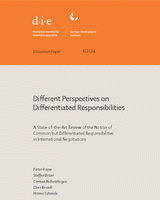Different perspectives on differentiated responsibilities: a state-of-the-art review of the notion of common but differentiated responsibilities in international negotiations
Pauw, Pieter / Steffen Bauer / Carmen Richerzhagen / Clara Brandi / Hanna SchmoleDiscussion Paper 6/2014
Bonn: German Development Institute / Deutsches Institut für Entwicklungspolitik (DIE)
ISBN: 978-3-88985-596-1
Price: 6 €
Chin. Ausg. u.d.T.:
Guanyu you qubie de zeren de butong guandian: guoji tanpan zhong youguan gongtong dan you qubie de zeren  gainian de zui xin pingshu (关于有区别的责任的不同观点 国际谈判中有关共同但有区别的责任概念的最新评述)
gainian de zui xin pingshu (关于有区别的责任的不同观点 国际谈判中有关共同但有区别的责任概念的最新评述)
(Discussion Paper 22/2014)
Anthropogenic climate change is a formidable global challenge. Yet countries’ contributions to global greenhouse gas emissions and the climate change impacts they face are poles apart. These differences, as well as countries’ different capacities and development levels, have been internationally acknowledged by including the notion of Common But Differentiated Responsibilities (CBDR) and Respective Capabilities under the 1992 United Nations Framework Convention on Climate Change (UNFCCC). The logic of CBDR was paramount in enabling negotiators to agree on an international legal framework for climate policy in the 1990s. Quite paradoxically, however, it has since proved to be a major obstacle in negotiating a universal new climate agreement, now envisioned for 2015 under the UNFCCC’s “Durban Platform”. The UNFCCC’s original dichotomous differentiation between “Annex I” parties (basically comprising “industrialised countries”) and “Non-Annex I” parties (i.e. developing countries) reflects neither scientific knowledge nor current political realities. The system of international climate policy has thus become dysfunctional. In fact, mitigation efforts by industrialised countries alone would be insufficient to avoid dangerous climate change, even if they were far more ambitious than they currently are. The diversification of state groups and country coalitions among developing countries, and the rise of emerging economies such as China and India – now among the world’s major greenhouse gas emitters – warrant a critical reconsideration of the conceptualisation and implementation of CBDR. Yet, no progress has been made so far to adequately adjust for the UNFCCC’s principled anachronism. It is against this background that this DIE Discussion Paper presents a state-of-the-art review of the notion of CBDR in international negotiations. It thus aims to identify mechanisms that could contribute to reinvigorating CBDR as a meaningful guiding principle for a 2015 climate agreement under the UNFCCC. To this end, it first considers the normative framing of CBDR and reviews the way CBDR has been conceptualised and interpreted in the academic literature. Second, it scrutinises the way CBDR manifests itself under the UNFCCC and how it explains the Annex I / Non-Annex I dichotomy before it summarises the respective political standpoints of some of the UNFCCC’s most important and influential parties (or groups of states). Third, it provides an analysis of the way CBDR or CBDR-like approaches have been put into practice in a variety of international regimes and policy arenas, including the World Trade Organization, the Montreal Protocol and the burgeoning debate on universal Sustainable Development Goals. The discussion paper thus brings forward different approaches for the attribution of emissions, criteria and means that allow for a differentiation of responsibilities for the reduction and limitation of emissions, as well as for mechanisms that facilitate broad participation in the conceptualisation and implementation of CBDR. It concludes that a flexible implementation of CBDR is needed to take into account the multiplication of country coalitions among developing countries and the rise of emerging economies. Finally, we argue for a flexible regime that would include differentiation of state groups beyond the Annex I / Non-Annex I dichotomy, with graduation and exclusion mechanisms that are based on a set of transparent, measurable and verifiable indicators of development, emissions and capacities.



